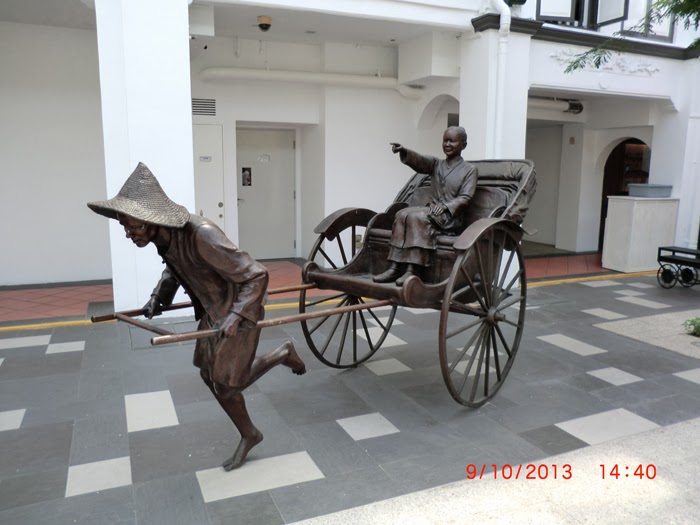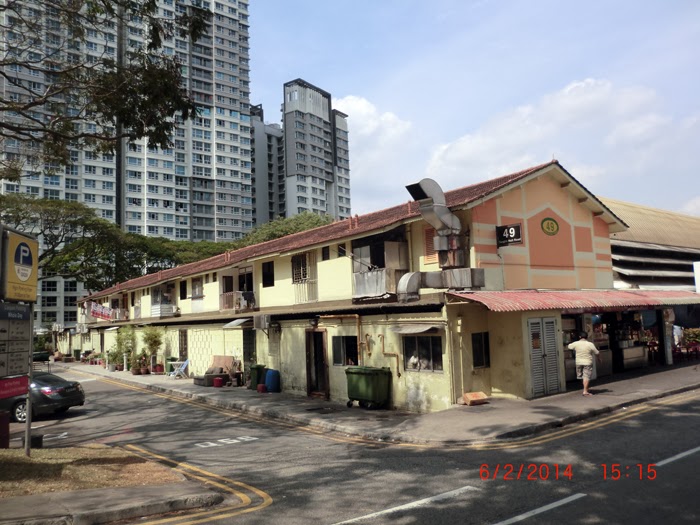Hokien Street in Singapore - Then and Now
 |
| Hokien Street in Singapore c.1900 |
 |
| Courtesy of National Heritage Board & Central Singapore |
Early Chinese immigrants tended to congregate in ethnic enclaves, of which Hokien and Upper Hokien Streets were two such areas. These streets were home to Hokkien immigrants from the Anxi district of Fujien province, where tea cultivation was a major activity. Bringing their trade with them, many Anxi Hokkien immigrants became tea merchants in Singapore.
Besides the tea trade, another industry that flourished on Hokien and Upper Hokien Streets was carriage making. In the very early days of the settlement, c.1819-1880, horse carriages were a common sight. Used mostly by the British community, horse carriages could be seen making their rounds every evening along the Esplanade and the Padang, two areas where most of the British built the bungalows. But for the local residents of Hokien and Upper Hokien Streets, building horse carriages was simply a way to earn a living.
In the pre-war years, Upper Hokien Street acquired a less savoury reputation. Exclusive brothels operating here were patronised by a wealthy and ostentatious clientele. These, however, were shut down by the 1950s. Hokien and Upper Hokkien Streets later became famous for their hawker food.
These life-sized bronze sculptures of the various portable hawkers and tradesmen in Hokien Street as a tribute to the pioneer generations in Singapore.
Hokien Street in Singapore - Then
The archived photos of Hokien Street in the 1950s are curated with the courtesy of the National Archives of Singapore (NAS). With thanks and acknowledgement to NAS posted to share on this blog for non-commercial purposes.
The old shophouses and streets at Hokien Street in these photos revived my fond nostalgic childhood memories when my mother first brought me to visit her relatives when I was 6 or 7 years old. An old town crowded with pedestrians, trishaws, bicycles but few cars. I remembered a market shop at the corner of Hokien Street and was curious about an old gas-lighted street lamp in the past (similar to the photo below).
During that time, Hokien Street was a central business district and the tallest building was the 18-storey Asia Insurance Building. There were no tall buildings with business offices, foreign or local banks. The main activities around Boat Quay, the godowns mainly the entrepot trade along the Singapore River. There were "coolies" and other workers to perform menial jobs working under the scorching hot sun or when it rained.
People were dressed simply and comfortably to suit the tropical weather. Most ladies wore samfoo in the street and men in plain shirts or singlets and shorts. Before the days of permed hair, cosmetics to make up with brightly colored lipsticks and painted nails, painted faces. The young ladies were not modern fashion-conscious and a very different lifestyle then and now.
Many men and ladies were wearing clogs and did not wear imported leather footwear with fashionable design in the public. Over the decades, the evolution of fashion and social transformation among the town folks in Hokien Street could be seen visibly.
If I could "transport" myself via extra-sensory perception (ESP) or a time-machine back to Hokien Street five decades ago, it was a very different world on a little street in Singapore. It was like the olden days of a different era when people and vehicles moved slowly like time stood still. But as the world changed, the global city of Singapore advanced and moved on with the times in so many ways. A new generation with improved education for opportunities for jobs; aspirations with hopes and blessings for a better place for future generations.
Hokien Street in Singapore - Now
 |
| Courtesy of National Heritage Board |
Established in 1854, Chui Eng Free School was one of the oldest Chinese schools in Singapore. Chui Eng Free School was an early Chinese learning institution which was set up by private individuals but open to provide free education for all.
From the inscription plaques found inside the school, historians established that Chi Eng was built by Tan Kim Seng and other wealthy and prominent Hokkien leaders who were immigrants from Malacca.
A plaque in Chui Eng Free School expressed the wish of its founders, "Someday when many are educated and everyone knows the Way of Confucious, to transform this barren land into a place of the learned."
 |
| The century-old heritage conservation project building in Hokien Street |
Another entrance into Hokien Street from South Bridge Road, traffic moving towards Neil Road and the Pinnacles@Duxton as shown in the background of the photo.
 |
| The landscaped backlane of the old buildings in Hokien Street |
Tan Hock Seng Biscuit Shop was near Hokien Street where my mother once stayed during the Japanese Occupation. Her favorite biscuits were the "beh teh saw" and "phong piah". The Hokkien colloquial for "phong piah" means somebody gets a scolding - "吃碰饼" (eat "phong piah") not a good name to use, but good and tasty to eat!
The YouTube video with courtesy of Sen. Thanks for sharing on this blog.































































































